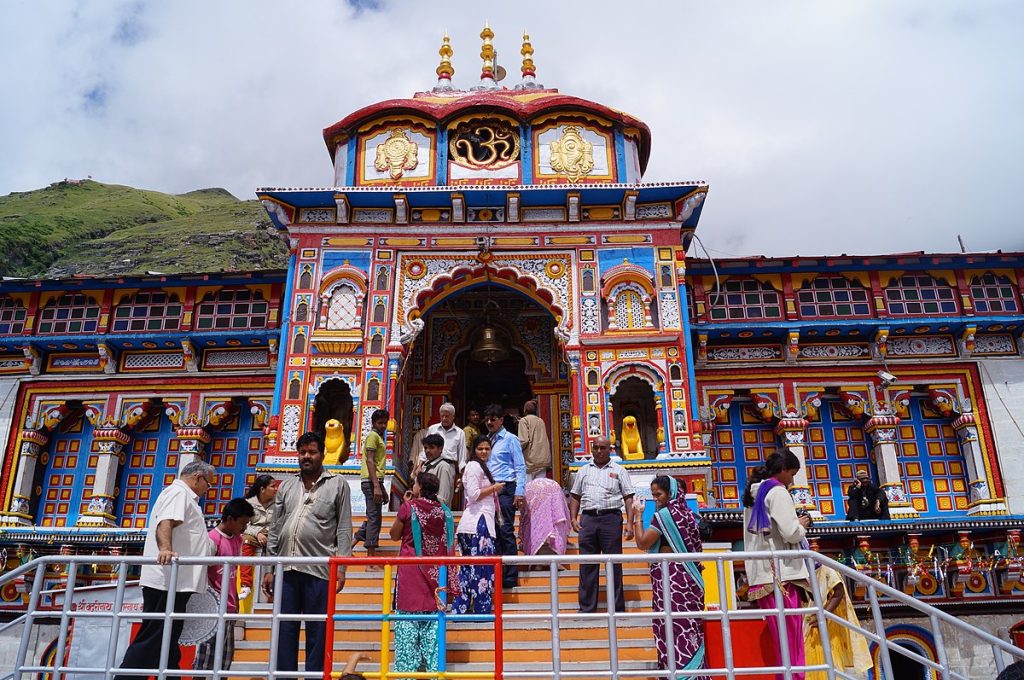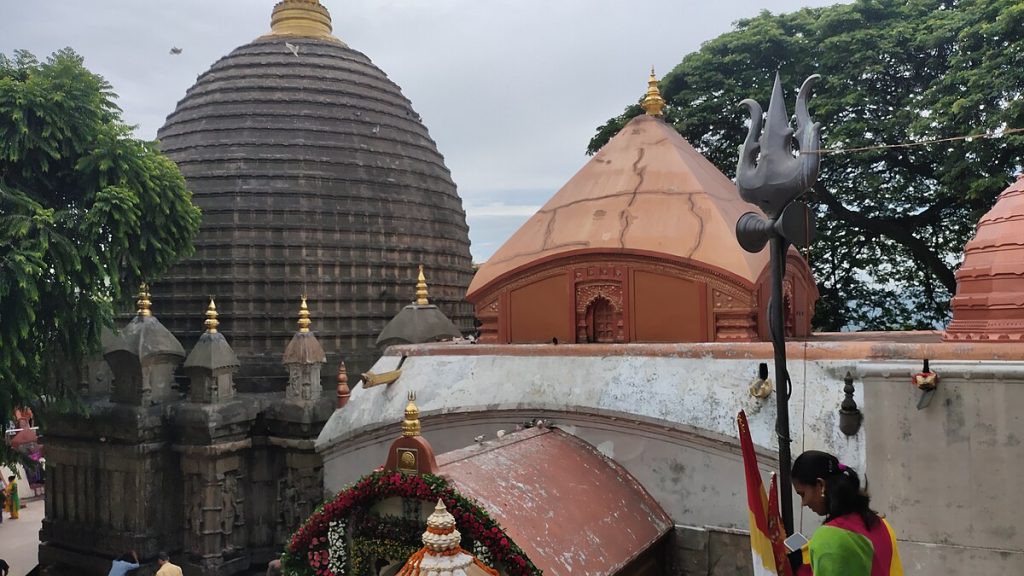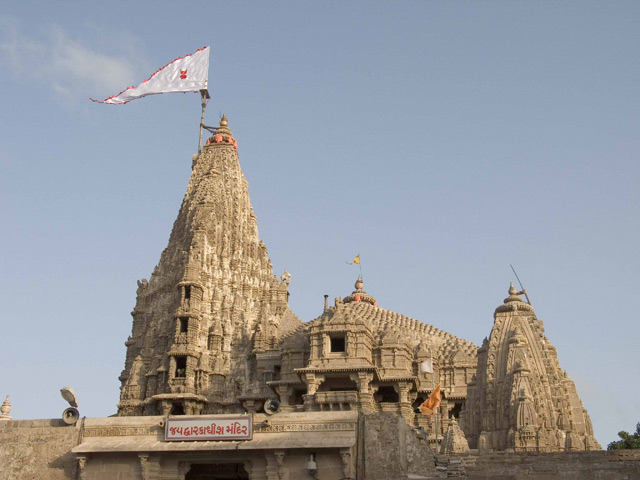India, a land steeped in ancient traditions and spirituality, is home to countless iconic temples that have stood the test of time, bearing witness to the country’s rich cultural heritage. These sacred spaces, adorned with intricate carvings and architectural grandeur, are not just places of worship but living embodiments of India’s diverse beliefs, legends, and spiritual practices.
Importance of Temple Tourism in India’s Cultural Landscape
Temple tourism has emerged as a significant aspect of India’s cultural landscape. Every year it draws millions of devotees and travelers from around the world. These architectural marvels offer a unique opportunity to immerse oneself in the country’s vibrant traditions, witness age-old rituals, and connect with the profound spiritual energy that permeates these sacred spaces.
North India’s Iconic Temples

A. Badrinath Temple – Chamoli, Uttarakhand
Nestled in the mighty Garhwal Himalayas, the Badrinath Temple is one of the most revered Hindu shrines and a part of the sacred Char Dham pilgrimage circuit. Dedicated to Lord Vishnu, this ancient temple is adorned with exquisite carvings and offers breathtaking views of the surrounding snow-capped peaks.
B. Kedarnath Temple – Rudraprayag, Uttarakhand
Another jewel in the Char Dham circuit, the Kedarnath Temple is dedicated to Lord Shiva and is believed to be one of the twelve Jyotirlingas, or sacred abodes, of the Lord of Destruction. The temple’s location, surrounded by towering peaks and glaciers, adds to its spiritual aura and draws thousands of devotees each year.
C. Golden Temple – Amritsar, Punjab
The Golden Temple, also known as the Harmandir Sahib, is the holiest site in Sikhism and a stunning architectural marvel. The temple’s iconic golden domes and marble work, reflecting in the sacred waters of the Amrit Sarovar, create a serene and spiritual ambiance that attracts millions of visitors each year.
D. Kashi Vishwanath Temple – Varanasi, Uttar Pradesh
Varanasi, the spiritual capital of India, is home to the revered Kashi Vishwanath Temple, dedicated to Lord Shiva. This ancient temple, with its intricate carvings and celestial energy, is a must-visit for devotees seeking spiritual enlightenment and a glimpse into India’s rich cultural heritage.
E. Yamunotri Temple – Uttarkashi, Uttarakhand
The Yamunotri Temple, situated at the source of the sacred Yamuna River, is the first stop on the Char Dham pilgrimage circuit. This temple, dedicated to the goddess Yamuna, offers a serene escape from the hustle and bustle of daily life, surrounded by the majestic Himalayas.
F. Amarnath Cave Temple – Jammu and Kashmir
The Amarnath Cave Temple, located in the heart of the Himalayas, is a revered Hindu shrine dedicated to Lord Shiva. The cave, with its naturally formed ice lingam, is accessible only during the summer months, making the pilgrimage a challenging yet spiritually rewarding experience.
G. Neelkanth Mahadev Temple – Rishikesh, Uttarakhand
The Neelkanth Mahadev Temple in Rishikesh is a lesser-known gem that offers stunning views of the Ganga River and the surrounding Himalayan ranges. This temple, dedicated to Lord Shiva, is a popular stop for devotees embarking on the Char Dham pilgrimage.
South India’s Iconic Temples

A. Brihadeeswara Temple – Thanjavur, Tamil Nadu
The Brihadeeswara Temple, a UNESCO World Heritage Site, is a architectural masterpiece of the Chola dynasty. This grand temple, dedicated to Lord Shiva, boasts a massive granite vimana (tower) that stands as a testament to the engineering prowess of ancient Indian architects.
B. Ramanathaswamy Temple – Rameshwaram, Tamil Nadu
The Ramanathaswamy Temple in Rameshwaram is one of the most sacred and revered iconic temples in South India. Dedicated to Lord Shiva, this temple is believed to have been built by Lord Rama himself and is a major pilgrimage site for Hindus.
C. Meenakshi Temple – Madurai, Tamil Nadu
The Meenakshi Temple in Madurai is a architectural marvel that showcases the intricate craftsmanship of the Dravidian style. This temple, dedicated to the divine couple Meenakshi and Sundareshwarar, is renowned for its vibrant gopurams (towering gateways) and intricate carvings depicting scenes from Hindu mythology.
D. Tirupati Balaji Temple – Tirumala, Andhra Pradesh
The Tirupati Balaji Temple, also known as the Venkateshwara Temple, is one of the most revered and visited Hindu shrines in India. Located atop the Venkata Hill in Tirumala, this temple is dedicated to Lord Venkateshwara, an avatar of Lord Vishnu, and attracts millions of devotees each year.
E. Virupaksha Temple – Hampi, Karnataka
The Virupaksha Temple in Hampi is a stunning example of Vijayanagara architecture and is dedicated to Lord Shiva. This temple, with its intricate carvings and towering gopurams, is a highlight of the UNESCO World Heritage Site of Hampi and a must-visit for history and architecture enthusiasts.
F. Gomateshwara Temple – Shravanabelagola, Karnataka
The Gomateshwara Temple in Shravanabelagola is a revered Jain pilgrimage site that houses a massive monolithic statue of Lord Bahubali. This temple, with its intricate carvings and serene surroundings, offers a glimpse into the rich cultural heritage of Jainism.
G. Sri Ranganathaswamy Temple – Srirangam, Karnataka
The Sri Ranganathaswamy Temple in Srirangam is one of the largest and most revered Vaishnavite temples in India. This massive complex, dedicated to Lord Ranganatha, an avatar of Lord Vishnu, boasts intricate carvings, towering gopurams, and a rich history spanning centuries.
H. Shri Padmanabhaswamy Temple – Trivendrum, Kerala
The Shri Padmanabhaswamy Temple in Trivandrum is a sacred Hindu temple dedicated to Lord Vishnu. This temple is renowned for its architectural splendor, including intricate carvings, murals, and a massive underground vault that contains immense wealth.
East India and Central India’s Iconic Temples

A. Kamakhya Temple – Guwahati, Assam
The Kamakhya Temple in Guwahati is one of the most revered Shakti Peethas (sacred sites) in India and is dedicated to the Mother Goddess Kamakhya. This temple, with its unique architecture and rich cultural heritage, is a must-visit for those interested in exploring the spiritual traditions of Northeast India.
B. Sun Temple – Konark, Odisha
The Sun Temple in Konark is a UNESCO World Heritage Site and an architectural marvel dedicated to the Sun God, Surya. This temple, with its intricate carvings and unique chariot-like design, is a testament to the engineering prowess of ancient Indian architects.
C. Shri Jagannath Temple – Puri, Odisha
The Shri Jagannath Temple in Puri is one of the most significant Hindu temples in India, dedicated to Lord Jagannath, an avatar of Lord Vishnu. This temple is renowned for its grand annual chariot festival, the Rath Yatra, which attracts millions of devotees from across the globe.
D. Lingaraja Temple – Bhubaneswar, Odisha
The Lingaraja Temple in Bhubaneswar is a magnificent example of Kalinga architecture and is dedicated to Lord Shiva. This temple, with its towering spire and intricate carvings, is a symbol of Odisha’s rich cultural heritage and a must-visit for architecture enthusiasts.
E. Sanchi Stupa – Sanchi, Madhya Pradesh
The Sanchi Stupa, a UNESCO World Heritage Site, is a remarkable example of Buddhist architecture and art. This ancient stupa, adorned with intricate carvings and sculptures, offers a glimpse into the rich cultural heritage of Buddhism in India.
F. Khajuraho Temple – Khajuraho, Madhya Pradesh
The Khajuraho Temples, a UNESCO World Heritage Site, are renowned for their intricate and erotic carvings that depict various aspects of human life and Hindu mythology. These temples, built between the 10th and 11th centuries, are architectural marvels that showcase the artistic and engineering prowess of the Chandela dynasty.
G. Mahabodhi Temple – Gaya, Bihar
The Mahabodhi Temple in Gaya is a UNESCO World Heritage Site and a sacred Buddhist pilgrimage destination. This temple marks the location where Lord Buddha attained enlightenment under the Bodhi Tree and is a symbol of peace, wisdom, and spiritual awakening.
H. Mukteswara Temple – Bhubaneswar, Odisha
The Mukteswara Temple in Bhubaneswar is a stunning example of Kalinga architecture and is dedicated to Lord Shiva. This temple, with its intricate carvings and unique design, is a must-visit for those interested in exploring the architectural heritage of Odisha.
I. Laxminarayan Temple – Delhi
The Laxminarayan Temple, also known as the Birla Mandir, is a Hindu temple located in the heart of Delhi. This modern temple, with its intricate carvings and stunning architecture, is a unique blend of traditional and contemporary styles and a must-visit for those exploring the city.
J. Iskcon Temple – Vrindavan, Uttar Pradesh
The Iskcon Temple in Vrindavan is a stunning complex dedicated to Lord Krishna and is a prominent center of the Hare Krishna movement. This temple, with its vibrant atmosphere, intricate carvings, and spiritual energy, attracts devotees and visitors from around the world.
West India’s Iconic Temples

A. Siddhivinayak Temple – Mumbai, Maharashtra
The Siddhivinayak Temple in Mumbai is one of the most revered and visited Hindu shrines in India. This temple, dedicated to Lord Ganesha, is renowned for its intricate carvings and is believed to grant success and prosperity to its devotees.
B. Shirdi Sai Baba Temple – Shirdi, Maharashtra
The Shirdi Sai Baba Temple is a revered pilgrimage site dedicated to the famous saint Sai Baba of Shirdi. This temple, with its vibrant atmosphere and devotional energy, attracts millions of devotees each year seeking spiritual guidance and blessings.
C. Dwarkadhish Temple – Dwarka, Gujarat
The Dwarkadhish Temple in Dwarka is one of the holiest sites for Vaishnavas, or devotees of Lord Vishnu. This ancient temple is believed to have been built by Lord Krishna himself and is renowned for its intricate carvings and architectural splendor.
D. Somnath Temple – Somnath, Gujarat
The Somnath Temple, located on the western coast of Gujarat, is one of the most sacred Shiva shrines in India. With a history dating back to the 7th century, this temple has witnessed numerous invasions and reconstructions, yet it continues to stand as a testament to the resilience of India’s cultural heritage.
E. Ranakpur Temple – Pali, Rajasthan
The Ranakpur Temple in Pali, Rajasthan, is a stunning Jain temple renowned for its intricate carvings and architectural brilliance. This temple, with its intricate marble work and serene atmosphere, is a testament to the rich cultural heritage of Jainism in India.
Conclusion
India’s top temples are not just architectural marvels but living embodiments of the country’s rich cultural heritage, spiritual beliefs, and artistic traditions. From the towering spires of the Brihadeeswara Temple to the intricate carvings of Khajuraho, and from the serene ambiance of the Golden Temple to the vibrant energy of the Meenakshi Temple, these sacred spaces offer a captivating glimpse into the diverse tapestry of India’s spiritual and architectural legacy.
To truly appreciate the magnificence and spiritual essence of India’s top temples, one must experience them firsthand. Immerse yourself in the vibrant rituals, witness the ancient traditions, and let the architectural grandeur transport you to a realm where the past and present converge seamlessly. Embark on a journey through these sacred spaces, and you’ll come away with a deeper understanding and reverence for India’s enduring cultural heritage and the unwavering spirit of devotion that has shaped these iconic temples for centuries.